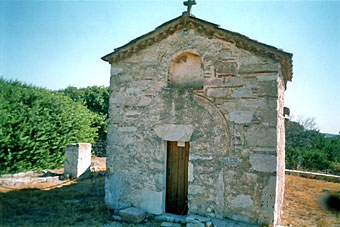Type: Cross - Vaulted
Date: 12th century
Description:
The church is situated on the road that leads from Koropi to Bari, approximately eight kilometers away from Koropi. This area is known from the medieval period as Lamprika. In its present state, it is an aisleless cross-vaulted church founded in the 12th century, according to Professor Bouras. According to him, the present form of the church doesn’t seem to be so old. In all probability, it is the re-construction of the initial building, out of which only a few remnants still survive nowadays. The morphological features that survive from the initial church are found in the barrel-vaulted, elevated narthex in the west. These features are the following: the cloisonné masonry, the dentil cornices and the big horseshoe arches of the windows in the three sides. The wall paintings preserved in the interior of the church are noteworthy and they belong to three different phases, post Byzantine till more recent ones. After the latest maintenance and restoration work from the Ministry of Culture, spoils from the initial decoration were revealed, probably dating to the 13th century. Many ancient spolia have been walled in the church. Judging from the lack of sculptures from the middle Byzantine period we reach the conclusion that there must not have been a sculptural décor in the initial monument. The church was the katholicon of a Monastery of the Church of Athens, which is identified with the Monastery mentioned in the act of Pope Innocent IV in 1209. During this period, Attica was dominated by the French dynasty De la Roche. This is the only historical evidence on this church till this day. In a small distance in the west of the church lies the convent of Hagia Triada. The katholicon of this convent consists of four small churches full of post Byzantine wall paintings, whereas the whole area is studded with remnants of buildings from different periods. Apart from the afore-mentioned small churches, part of this cluster of post Byzantine monuments are the small churches of Hagios Konstantinos and Ioannis Prodromos, as well as the post Byzantine phase of Hagios Lukas. Moreover, the deserted church of Hagios Kosmas is another Byzantine monument in the area of Hagios Lukas.
Lamprika: This is the name of the area that spreads in the south of Koropi and includes important Byzantine and post Byzantine monuments. Many scholars based on literary evidence, inscriptions and remnants of fragments found in the area report that there was situated the ancient demos of "Kath' Yperthen Lamptrai". This ancient name seems to survive in the present name Lamprika. A prosperous medieval settlement must have existed here during the medieval period. The existence of post Byzantine remnants is confirmed both by the accounts of 17th century travelers and by the remains of human activity. The latter are evident in the area to a great extent, even nowadays: wells, big built earthenware jars, half deserted stone-built buildings, shells from mainly unpainted pots, but also scattered building material, which was chiefly used in dry stone walls.
Koder J.-Hild F., Hellas und Thessalia, Taboula Imperii Bizantini I, 1976, p. 193.











